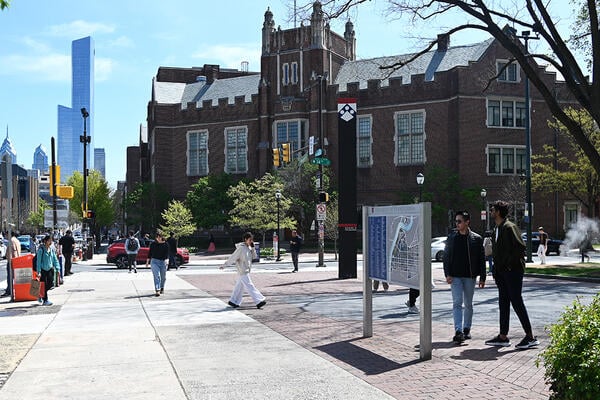The Department of Education’s demands that University of Pennsylvania “restore” swimming awards and honors that had been “misappropriated” to trans women athletes and apologize to the cisgender women who had lost to them offer a glimpse into how the second Trump administration could use Title IX to force certain changes at colleges, experts and attorneys say.
The demands, issued April 28 in the form of a proposed resolution agreement, would resolve a civil rights investigation that found Penn violated Title IX by “permitting males to compete in women’s intercollegiate athletics and to occupy women-only intimate facilities.” The Office for Civil Rights didn’t offer specifics, but officials were likely referring to trans swimmer Lia Thomas, who competed on the university’s women’s team in the 2021–22 academic year.
Today is the deadline for Penn to either agree to the proposed demands or potentially face consequences. Department officials said they would refer to the case to the Justice Department for possible enforcement—a process that could end with the university losing access to federal funding—if Penn didn’t comply. (Penn has already lost $175 million in federal funding over this issue, though White House officials said that decision was separate from the Office for Civil Rights inquiry.)
Penn is among several colleges and K-12 schools, including San José State University, facing investigations over policies related to trans athletes, but Penn is the first college to be the target of such public demands. Experts say the speed of the investigation, OCR’s unusual demands and the fact that Penn was in compliance with Title IX at the time Thomas competed there reflect a shift toward a more aggressive use of Title IX to further President Donald Trump’s anti-trans agenda.
The crazy part of all of this is they may be asking Penn to discriminate in doing so, because the Trump administration has its interpretation, but that’s not definitive.”
—Brett Sokolow, former president of the Association of Title IX Administrators
Opposing Interpretations
The administration’s forceful attack on institutions that have been home to high-profile trans women athletes fits with its overall playbook, which includes using any tools at its disposal to advance Trump’s agenda.
In the case of trans athletes’ participation in athletics, the weapon of choice is Title IX, the 52-year-old law passed to guarantee women equal opportunity to education, which has since been interpreted as a broad tool to address sex-based discrimination and harassment on campus.
In recent years, though, the relationship between trans students’ rights and Title IX has become complicated. Those on the left argue that the nature of Title IX is to protect students from gender-based discrimination, and that includes discrimination against trans and nonbinary individuals. (Such protections were included in the Biden administration’s short-lived Title IX regulations.) But those on the right argue that allowing trans women to participate women’s sports and to use women’s bathrooms and locker rooms violates the rights of their cisgender teammates—a perspective the Trump administration squarely aligns with.
“The previous administration trampled the rights of American women and girls—and ignored the indignities to which they were subjected in bathrooms and locker rooms—to promote a radical transgender ideology,” Craig Trainor, acting assistant secretary for civil rights, said in a statement when the Penn investigation was first announced.
For those in the former camp, Trump’s demands of Penn are just another example of the president using any means possible to erode trans people’s rights.
“The news out of Penn, to me, was just another example of the way they are, unfortunately, using [Title IX] as a battering ram to beat down safe and inclusive school environments for trans students,” said Emma Grasso Levine, senior manager of Title IX policy and programs at Advocates for Youth, a youth sexual health and LGBTQ+ equality advocacy organization.
Conservative organizations, though, have applauded the proposed resolution agreement, with the Alliance Defending Freedom, a conservative Christian legal group that has repeatedly sued to prevent trans women from playing on women’s sports teams and using women’s locker rooms and bathrooms, calling it “another step in the right direction to restore fairness and safety in women’s sports.”
An Aggressive Tack
Since taking office in January, Trump has rolled back trans students’ rights, including signing an executive order banning trans student athletes from playing on the teams that align with their gender. That order prompted the Penn investigation, but at the time that Thomas was competing, trans women who met certain requirements related to hormone therapy—as Thomas did—were permitted by the NCAA and governmental regulations to compete on women’s teams.
The NCAA has since changed that rule. But despite the NCAA’s stance and the executive order, current Title IX regulations do not disallow trans women from playing women’s sports. In fact, the regulations are the exact same set of rules, passed by the first Trump administration in 2020, that were in place when Thomas swam for Penn. This raises the question, experts say, of whether Penn should be penalized under Title IX despite the fact that the institution was following those regulations to the best of its ability.
“That’s the interesting challenge, and probably where Penn will hang its hat if it fights this: ‘There was an interpretation of Title IX in place at the time that Penn followed. And there’s an interpretation of Title IX that’s different now. How is it fair to impose today’s interpretation of Title IX on a previous time period?’” said Brett Sokolow, former president of the Association of Title IX Administrators and chair of the crisis management consulting and law firm TNG Consulting.
This is just one element of the aggressive tack the Trump administration appears to be taking against institutions that allowed trans women to play women’s sports. Multiple experts also pointed out the quick, almost dizzying timeline of OCR’s investigation into Penn.
Timeline of Penn Investigation
Feb. 5: Trump signs executive order prohibiting trans athletes from playing on teams that match their gender identity.
Feb. 6: Trump launches investigation into Penn. NCAA ends policy allowing trans athletes to play on teams that match their gender identity.
March 19: Trump administration pauses $175 million in federal funds to Penn.
April 28: OCR says Penn violated Title IX and must “restore” swimming honors given to trans women.
Ordinarily, investigations can take years to conclude—something that has often been a pain point for victims’ rights advocates, who argue that those timelines can seriously impede victims’ ability to complete their studies.
But OCR launched this investigation within a month of Trump entering office—and just two days after he signed the EO related to trans athletes—and resolved it less than three months later.
It’s also unusual for OCR to target a specific student with a resolution agreement, Sokolow said; most such agreements are stripped of names and identifying details. Although Thomas is not named in the department’s press release, it does call out her sport, swimming, and there have been no other out trans athletes at Penn.
“It’s very indicative of this administration—and concerning—that they’re targeting one person and demonizing them,” he said.
Experts also say the demands marks a sharp contrast from how OCR has resolved such cases in the past. Levine said that the requirements in resolution agreements are meant to “meaningfully impact a culture of sex-based harassment,” but she feels that OCR’s demands wouldn’t do that—if such a culture even exists at Penn.
Title IX ‘Pendulum Swing’
If Penn fights the demands, the case could put the war between those who seek to protect trans athletes from discrimination and those who want to see them excised from their sports teams to the test. And until courts settle the question, students and institutions will be in limbo.
“The crazy part of all of this is they may be asking Penn to discriminate in doing so, because the Trump administration has its interpretation, but that’s not definitive,” Sokolow said. “It does not have the force of law. If a court were to rule on this that Lia Thomas had rightfully won whatever competition the Trump administration is concerned about, any move to force to Penn to remove those victories could be discriminatory against a person who’s trans.”
Icon Sportswire/Contributor/Getty Images
Patricia Hamill, co-chair of the Title IX and campus discipline practice at Clark Hill, a Washington law firm, told Inside Higher Ed via email that the case “highlights the pendulum swing of Title IX in its enforcement and interpretation as well as in the government priorities over the last decade. Institutions are continuously being challenged on how to best to handle these very difficult situations on ground that continues to shift both because of Administration changes but also because of societal changes.”
Penn had not publicly commented on the proposed resolution agreement as of Wednesday evening. When news broke that the government was suspending its federal funds, Penn officials stressed in a statement that its “athletic programs have always operated within the framework provided by the federal government, the NCAA and our conference.”
Title IX experts expect that if the university does challenge the proposed agreement in court, it will focus on that very argument—that when Thomas was competing on Penn’s swim team, the university was, in fact, complying with NCAA rules and the department’s guidance.












